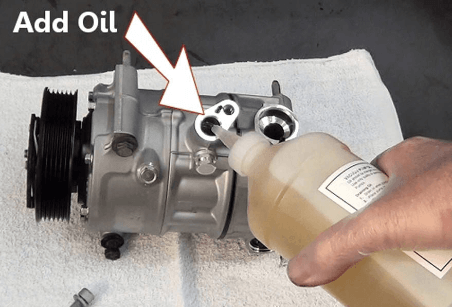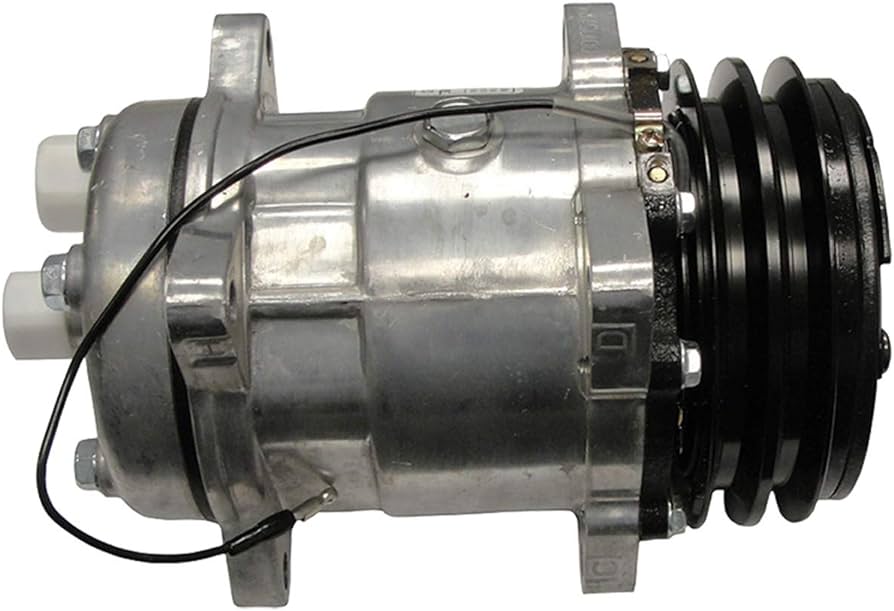When replacing a compressor, the amount of PAG oil to add depends on the specific vehicle and compressor model. It is important to consult the vehicle’s manual or manufacturer’s guidelines to determine the correct amount.
Adding too much oil can hinder performance and displace refrigerant, potentially leading to compressor burnout. It is crucial to ensure that the oil added is contaminant-free and compatible with the system.
If the system has previously been installed, it is recommended to remove as much of the original oil charge as possible to prevent an oil overcharge.
Consult a professional or refer to forums and resources specific to your vehicle for more information.
Click Here to find out recommended Pag oil
1. Understanding The Importance Of Pag Oil In Ac Systems
Discuss The Role Of Pag Oil In Maintaining The Functionality And Longevity Of Ac Compressors.
Pag oil plays a crucial role in the proper functioning and longevity of AC compressors. As a lubricant, it ensures that the compressor’s moving parts operate smoothly, reducing friction and preventing damage or wear.
Without an adequate amount of Pag oil, the compressor may experience increased friction, which can lead to overheating and ultimately compressor failure. Additionally, Pag oil also helps in sealing the system and preventing leaks, contributing to the overall efficiency and effectiveness of the AC system.
Highlight The Compatibility Issues Between Different Types Of Compressor Oils.

It’s important to note that different types of compressor oils, such as Pag oil, mineral oil, and ester oil, are not always compatible with each other. Mixing incompatible oils can result in chemical reactions, oil breakdown, and system malfunctions.
For example, Pag oil is not compatible with mineral oil, which is commonly used in older AC systems. Mixing these two oils can lead to system clogs and reduced performance. Therefore, it is essential to use the appropriate type of oil specified by the manufacturer to ensure compatibility and prevent any potential issues.
Emphasize The Necessity Of Adding An Appropriate Amount Of Pag Oil When Replacing A Compressor.
When replacing a compressor in an AC system, it’s essential to add the appropriate amount of Pag oil to maintain proper lubrication and ensure the system’s longevity. Adding too little oil can result in insufficient lubrication, increasing friction and wear on the compressor.
On the other hand, adding too much oil can lead to oil overcharge, which can hinder performance and potentially damage the compressor.
So, how much Pag oil should be added when replacing a compressor? The exact amount may vary depending on the compressor’s type, size, and the specific requirements of the AC system.
It is recommended to consult the manufacturer’s guidelines or seek the advice of a professional technician to determine the correct amount of Pag oil to be added during the replacement process. This helps to ensure the optimal performance and longevity of the AC system while avoiding compatibility issues or potential damage caused by incorrect oil levels.
2. Determining The Correct Amount Of Pag Oil To Add
Explain How The Amount Of Pag Oil Needed Depends On Various Factors, Such As The System Capacity And The Type Of Compressor.
When it comes to determining the correct amount of Pag oil to add when replacing a compressor, it’s important to consider several factors. The amount of Pag oil needed will depend on the system capacity and the type of compressor being used.
System capacity refers to the amount of refrigerant the AC system can hold. Different AC systems have varying capacities, and this affects the amount of Pag oil required. Additionally, the type of compressor being used can also impact the amount of Pag oil needed.
For example, rotary compressors require less oil compared to reciprocating compressors. Therefore, it’s crucial to understand these variables in order to determine the correct amount of Pag oil to add.
Discuss The Importance Of Following Manufacturer Guidelines Or Recommendations For The Specific Ac System.
When it comes to the correct amount of Pag oil to add when replacing a compressor, it is crucial to follow manufacturer guidelines or recommendations for the specific AC system. Manufacturers have extensive knowledge and experience in designing and engineering their AC systems, including the appropriate amount of Pag oil required.
Following manufacturer guidelines ensures that the AC system operates efficiently and effectively. Adding an incorrect amount of Pag oil can have negative consequences, such as decreased cooling performance, compressor damage, or even system failure.
By adhering to the manufacturer’s recommendations, you can ensure that the AC system receives the optimal amount of Pag oil, leading to proper lubrication and overall system functionality.
Address Common Concerns And Misconceptions About Adding Too Much Or Too Little Pag Oil.
There are some common concerns and misconceptions surrounding the addition of too much or too little Pag oil when replacing a compressor. Let’s address these concerns and set the record straight.
Adding too much Pag oil can lead to performance issues. Excess oil can displace refrigerant, which is essential for cooling the compressor. This displacement can result in compressor burnout and potential system damage. It’s important to follow the manufacturer’s guidelines to prevent over-oiling the system.
On the other hand, adding too little Pag oil can also have negative consequences. Insufficient lubrication can lead to increased friction between the compressor components, causing premature wear and tear. This can result in reduced efficiency and potential compressor failure.
To avoid these issues, it’s crucial to carefully follow the manufacturer’s recommendations and guidelines for the specific AC system. By doing so, you can ensure the correct amount of Pag oil is added during compressor replacement, maintaining optimal system performance and longevity.
3. Steps To Add Pag Oil When Replacing A Compressor
When it comes to compressor replacement, adding the correct amount of Pag oil is crucial for the proper functioning of the AC system. Here is a step-by-step guide on how to add Pag oil during the compressor replacement process:
-
- Step 1: Safety Precautions and Best Practices
Before adding Pag oil, it is important to take the necessary safety precautions and follow best practices to ensure a smooth and successful oil addition process. Here are a few pointers to keep in mind:
-
-
- Ensure that you are working in a well-ventilated area to avoid inhaling any harmful fumes.
- Wear appropriate protective gear, such as gloves and safety goggles, to protect yourself from any potential oil spills or splashes.
- Consult the manufacturer’s guidelines or service manual to determine the correct type and amount of Pag oil to be added.
- Make sure that all the necessary tools, such as oil injectors or oil charge cans, are clean and in proper working condition.
- Step 2: Measurement and Controlled Dispensing
-
To ensure accurate measurement and controlled dispensing of Pag oil, it is recommended to use oil injectors or oil charge cans. These tools help in preventing over or undercharging the system. Here’s how to use them:
-
-
- Attach the oil injector or oil charge can to the designated port on the AC system.
- Follow the manufacturer’s instructions to fill the injector or can with the correct amount of Pag oil.
- Slowly and steadily inject or dispense the Pag oil into the system, taking care not to introduce any air bubbles.
- Continue the process until the recommended amount of Pag oil has been added.
- Step 3: Double-check and Verify
-
After adding the Pag oil, it is important to double-check and verify the amount added to ensure that it meets the specifications. Here’s what you can do:
-
- Inspect the AC system for any signs of leaks or spills.
- Check the oil level using a dipstick or sight glass, if available.
- If necessary, add additional Pag oil in small increments until the desired level is reached.
- Once the oil level is verified, proceed with the rest of the compressor replacement process.
By following these step-by-step instructions and adhering to the safety precautions and best practices, you can ensure a proper and accurate Pag oil addition during compressor replacement.

4. Common Issues And Troubleshooting
Address Potential Problems That May Arise During The Pag Oil Addition Process.
Adding the correct amount of Pag oil when replacing a compressor is crucial for the proper functioning of the AC system. However, the process can sometimes pose a few challenges. Here are some potential problems that you may encounter during the Pag oil addition process:
- Difficulty accessing the compressor: In some cases, the compressor may be located in a tight or hard-to-reach area, making it challenging to add the Pag oil.
- Lack of information: If you don’t have the specifications for the specific make and model of the compressor, determining the correct amount of Pag oil to add can be difficult.
- Contaminated oil: If the old compressor failed due to a catastrophic failure, there may be metal shavings or debris in the system. Adding an excessive amount of Pag oil can exacerbate the problem.
Discuss Possible Signs Of Overcharged Or Undercharged Systems.
After adding Pag oil to the AC system, it’s important to monitor the system for signs of undercharging or overcharging. Here are some possible signs to look out for:
| Overcharged System | Undercharged System |
|---|---|
|
|
Provide Troubleshooting Tips And Solutions For Resolving Oil-related Issues.
Dealing with oil-related issues in the AC system can be frustrating. However, there are some troubleshooting tips and solutions that you can try to resolve these problems:
- Check oil levels: Use an oil pressure gauge to ensure that the system has the correct amount of Pag oil. If it is overcharged or undercharged, adjust the levels accordingly.
- Flush the system: If there are contaminants or excess oil in the system, a full system flush may be necessary. This ensures that the AC system is free from debris and allows for the proper functioning of the new compressor.
- Consult the manufacturer specifications: Always refer to the manufacturer’s guidelines for the correct amount of Pag oil to add. These specifications are specific to each make and model and will help to avoid over or undercharging the system.
- Seek professional help: If you are unsure about the correct procedures or encountering persistent issues, it’s best to consult a professional technician who can diagnose and resolve the oil-related problems.
5. Maintenance Tips For Optimal Pag Oil Performance
Maintaining proper oil levels in AC systems is crucial for optimal performance and longevity. Regular inspections and oil checks are essential to ensure that the Pag oil levels are adequate and that the compressor is functioning correctly. In this section, we will share some maintenance tips to help you maintain the proper Pag oil levels in your AC system.
Share Maintenance Tips For Maintaining The Proper Oil Levels In Ac Systems.
Here are some tips to help you maintain the proper oil levels in your AC system:
- Regular inspections: It is important to inspect your AC system regularly to check the oil levels. This can be done by referring to the manufacturer’s specifications or consulting a professional.
- Oil checks: Along with regular inspections, performing oil checks is essential. This involves checking the oil level in the sight glass or using an oil dipstick, depending on the design of your AC system. If the oil level is below the recommended level, it is necessary to add Pag oil.
Discuss The Importance Of Regular Inspections And Oil Checks.
Regular inspections and oil checks are vital for several reasons:
- Optimal performance: By ensuring that the oil levels are within the recommended range, you can help your AC system function efficiently and deliver optimal performance.
- Preventing damage: Low oil levels can lead to insufficient lubrication, causing friction and damage to the compressor. Regular inspections and oil checks can help identify and address any potential issues before they escalate.
- Longevity: Proper maintenance, including regular inspections and oil checks, can extend the lifespan of your AC system by reducing wear and tear on the compressor.
Provide Recommendations On When To Add Additional Pag Oil And When To Replace The Oil Altogether.
Knowing when to add additional Pag oil or replace the oil altogether is essential for maintaining optimal AC system performance:
| When to Add Additional Pag Oil | |
|---|---|
| Scenario: | Recommendation: |
| The oil level is below the recommended range | Add the appropriate amount of Pag oil to reach the recommended level |
While adding Pag oil is often necessary, it’s important to note that excessive oil can be detrimental to your AC system’s performance. Adding too much oil can displace refrigerant and potentially lead to compressor burnout.
In some cases, it may be necessary to replace the oil altogether, especially if there have been contaminants introduced into the system or if the oil has degraded over time. Consult the manufacturer’s guidelines or seek professional advice to determine if oil replacement is necessary.
By following these maintenance tips and regularly checking your AC system’s oil levels, you can ensure optimal Pag oil performance and prolong the life of your compressor.
Frequently Asked Questions Of How Much Pag Oil To Add When Replacing Compressor
Do I Need To Add Pag Oil When Replacing Compressor?
No, you do not need to add PAG oil when replacing a compressor. However, it is important to remove as much of the original oil charge from the system as possible to avoid overcharging. It is typically okay for a small amount of oil to remain in the system as long as it is contaminant-free.
Adding too much oil can hinder performance and potentially cause compressor burn out.
How Much Oil Do I Put In After Compressor Replacement?
After compressor replacement, you need to add the same amount of oil as the new OEM compressor. Adding too much oil can hinder performance and displace refrigerant, leading to compressor burnout. Be careful not to exceed the recommended amount.
How Much Pag Oil Does A New Ac Compressor Take?
A new AC compressor typically requires the original OEM amount of PAG oil. It is important to get rid of any excess oil from the system to prevent overcharging. Adding too much oil can hinder performance and potentially damage the compressor.
Can You Put Too Much Pag Oil In Compressor?
No, adding too much PAG oil in a compressor is not recommended as it can hinder performance and potentially lead to compressor burnout. It is important to maintain the correct oil amount specified by the manufacturer for optimal functioning.
Conclusion
In order to maintain the optimal performance of your AC system, it is crucial to add the correct amount of PAG oil when replacing the compressor. Adding too much oil can hinder the system’s performance and may lead to compressor burn out.
On the other hand, not adding enough oil can cause damage as well. It is recommended to follow the OEM guidelines and ensure that the system is free from contaminants. By adhering to these practices, you can ensure the longevity and efficiency of your AC system.


Leave a Reply